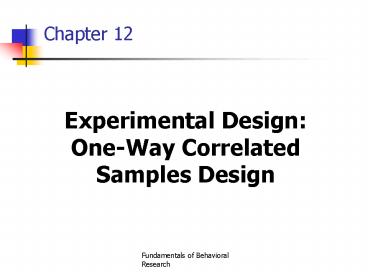Experimental Design: One-Way Correlated Samples Design - PowerPoint PPT Presentation
Title:
Experimental Design: One-Way Correlated Samples Design
Description:
... in one group (condition) is paired with a score in the other group(s) (condition ... A priori specific comparison test. Does not require significant F ... – PowerPoint PPT presentation
Number of Views:28
Avg rating:3.0/5.0
Title: Experimental Design: One-Way Correlated Samples Design
1
Chapter 12
- Experimental Design One-Way Correlated Samples
Design
2
Experimental Design One-Way Correlated Samples
Design
- Advantages and limitations
- Comparing two groups
- Comparing t-test to ANOVA
- Comparing more than two groups
3
Advantages and limitations
- One-way correlated samples
- One-way 1 IV
- Correlated samples no random assignment
- Each score in one group (condition) is paired
with a score in the other group(s) (condition(s)) - Advantages
- Can reduce systematic error (confounding)
- Can reduce random error (due to indiv diff)
- Limitations
- Creating pairs of participant scores may be
difficult - Repeated measurements can create methodological
concerns
4
Advantages and limitations
- Natural pairs
- Participants scores paired for some natural
reason - Matched pairs
- Participants scores paired because researcher
matches them on some variable - Repeated measures
- Participants scores paired because they come
from the same participants - Objective is to reduce sources of extraneous
variability
5
Advantages and limitations
- Advantages of repeated measures design
- Controls EVs due to individual differences
- Requires fewer participants
- Appropriate for studying questions that involve
repeated exposure/testing - Appropriate for longitudinal research
6
Advantages and limitations
- Methodological issues of repeated measures design
- Carryover effects
- Transient
- Permanent
- Sensitization
- Carryover effects can often be controlled by
- Randomized order of conditions
- counterbalancing
7
Advantages and limitations
- Comparing repeated measures design to independent
samples design - Effect on random error and inferential statistic
- Effect on degrees of freedom
- Consider the net effect
8
Comparing two groups
- Random sampling
- Paired assignment to 2 groups (conditions)
- 1 IV with 2 levels
- Lets try an experiment involving the Stroop
effect - Go to the following website
- http//faculty.washington.edu/chudler/java/ready.h
tml
9
Comparing two groups
- variability within groups (error variability)
random error (extraneous variables) - variability between groups systematic error
(confounds) systematic variability (effect of
IV) - Goals
- Reduce random error
- Eliminate systematic error
- Maximize systematic variability through
manipulation of IV
10
Comparing t-test to ANOVA
- Correlated samples t-test
- Limited to 2 groups
- Independent samples Analysis of Variance (ANOVA)
- 2 or more groups
- Both parametric tests
- Require assumptions of
- Normality
- Homogeneity of variance
11
Comparing t-test to ANOVA
- Correlated samples t-test
- difference between the 2 group means
- t ----------------------------------------------
------------ - standard error of the difference
between means - t values when null hypothesis is true
- t values when null hypothesis is false
- Larger the t (pos or neg), the lower the
probability that the difference is simply due to
chance - Alpha level and decision-making
12
Comparing t-test to ANOVA
- Correlated samples ANOVA
- variability between the two groups
- F ----------------------------------------------
------------ - error variability
- F values when null hypothesis is true
- F values when null hypothesis is false
- Larger the F, the lower the probability that the
difference is simply due to chance - Alpha level and decision-making
13
Comparing more than 2 groups
- Addition of groups often clarifies relationship
between IV and DV - ANOVA to determine effect
- A priori specific comparison test
- Does not require significant F
- post hoc specific comparison test
- Does require significant F
14
Summary
- Correlated samples design
- Random sampling
- Paired assignment
- Natural pairs
- Matched pairs
- Repeated measures
- Paired assignment designed to reduce random error
- Manipulation of IV
- Analyzed with t-test or ANOVA































